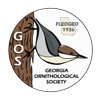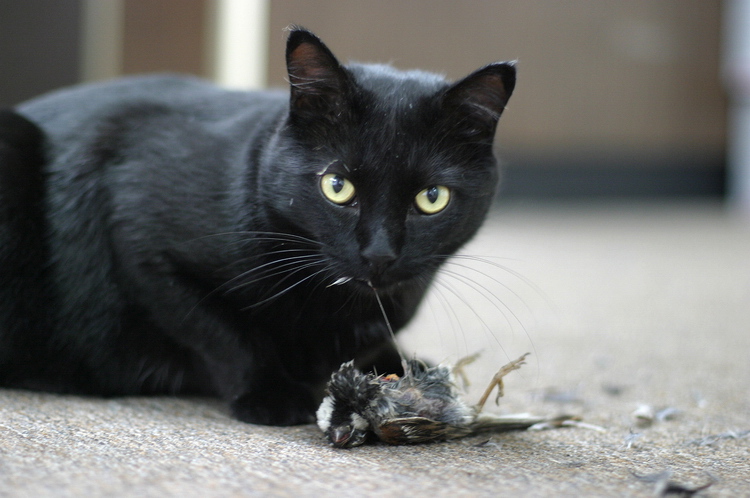Managing Feral and Free-ranging Domestic Cats
Birds in the United States contend with over 100 million non-native predators in the form of feral and free-ranging cats (Felis catus), the domestic descendents of wild cats (Felis sylvestris) from the Middle East. Predation by non-native species has been recognized as one of the most important causes of species extinction worldwide, and cats in particular have been identified as one of the leading drivers of global bird extinctions. Long-term monitoring data indicate that a majority of bird species in the United States have declined during the past several decades. Cat predation is one of the most important anthropogenic causes of bird mortality in the United States, exponentially exceeding mortality caused by cell phone towers, wind farms, human hunters, and many other factors.
Cat predation of birds is unlike that by any native predator in the United States, perhaps most importantly because cats are maintained in numbers far above natural carrying capacity. Unlike similarly-sized native predators, cats typically kill prey regardless of whether or not they will consume it. Well-fed cats are no less likely to kill, and outfitting cats with collar bells or declawing them does not prevent them from killing birds and other wildlife. While similarly-sized native predators may take eggs or nestlings of birds, no native mammalian predator routinely hunts adult birds, as cats do. Cats may be active during the day as well as at night, so wildlife is exposed to cat predation at all times. Cats are less motivated than wild predators to hide from people, so they commonly hunt in human-dominated environments where persisting wildlife already contends with multiple anthropogenic threats. Cat densities may be so high in urban areas that they reduce avian productivity to the extent that low predation rates may simply reflect low numbers of remaining birds. Recently fledged birds are especially vulnerable to predation by cats, as they are often incapable of flight for at least two to three weeks.
Georgia bird species at risk of predation by cats include songbirds whose populations are declining substantially such as Swainson's Warbler (Limnothlypis swainsonii), Golden-winged Warbler (Vermivora chrysoptera), and Painted Bunting (Passerina ciris), as well as the federally threatened Piping Plover (Charadrius melodus). Species that forage on the ground or in the understory, such as Georgia's state bird -- Brown Thrasher (Toxostoma rufum) -- are particularly vulnerable to cat predation. Data from many wildlife rehabilitation centers in the United States show that cat predation is the single largest reason for wildlife admission. Most cat attack victims do not survive, and animals attacked but not immediately killed may be subjected to intense, prolonged suffering before death. Cats may also harm wildlife populations by competing with native predators such as raptors, thereby diminishing food resources for those species, and by stimulating reductions in bird productivity caused by birds’ stress responses to predation risk.
While vaccinations may protect them from several diseases, domestic cats act as reservoirs and vectors for many diseases and parasites that jeopardize wildlife. Examples include the infection of the American mountain lion (Puma concolor) with feline leukemia and the infection of the federally endangered Florida panther (Puma concolor coryi) with feline panleukopenia, or feline parvovirus, an immunodeficiency disease. Cats play an integral role in the life cycle of the parasite Toxoplasma gondii, which has caused fatal infections of the federally endangered Hawaiian Crow (Corvus hawaiiensis) (now likely extinct in the wild) and federally threatened Southern sea otter (Enhydra lutris). T. gondii is known to have infected more than 50 bird species worldwide and at least a dozen bird species in the United States, including American Kestrel (Falco sparverius), Red-shouldered Hawk (Buteo jamaicensis), Great-horned Owl (Bubo virginianus), and Red-bellied Woodpecker (Melanerpes carolinus). T. gondii can be transmitted to humans through the eating of undercooked meat, or from exposure to cat feces. In some cases exposure does not produce symptoms, but in others, infection can cause permanent disabilities, such as blindness and learning disorders, and may be deadly to those with weakened immune systems.
The pet cat population of the United States has tripled during the past 40 years, and the number of abandoned and feral (unsocialized) cats likewise appears to have increased substantially. The need to control cat population growth is widely recognized by scientists, veterinarians, animal shelters and animal welfare groups. Traditional population control involves humanely trapping and removing unclaimed, stray, and feral animals from the environment. However, many special interest groups and several animal welfare groups now oppose these control methods, and instead promote feeding and sterilization programs often branded as “trap-neuter-release” or “trap-neuter-return” (TNR). In TNR programs, free-ranging cats are fed regularly at fixed locations and are the subjects of attempts, usually by volunteers, to trap, sterilize, and re-release them. TNR advocates typically claim that trap and removal methods are ineffective, and promote TNR as “the only humane, proven, and effective method” for reducing cat populations. While the idea may sound appealing, in reality TNR programs sanction the abandonment and neglect of cats. Increased abandonment of cats in areas where TNR is underway has been documented, apparently because people know that the animals will have easy access to food. Many veterinarians, animal rights advocates, and scientists object to TNR as inhumane, because it exposes both cats and wildlife to abuse, disease, and death by trauma.
TNR programs typically perpetuate an abundance of unsterilized cats. TNR is always accompanied by the unrestricted feeding of both sterilized and unsterilized cats; this unrestricted feeding increases the survival and breeding potential of cat colonies, negating any potential population control from sterilization. Mathematical models suggest that cat population growth can be controlled through the annual removal of at least 50% of the population or sterilization of more than 75% of the population. Empirical evidence to date suggests that TNR generally does not reduce free-ranging cat populations, almost never results in the elimination of feral cat colonies, and may even result in increasing cat populations. The large numbers of free-ranging cats subsidized by TNR programs can alter basic ecological processes, disrupt the balance of food chains, cause declines in biodiversity, and threaten the survival of endangered, sensitive, and protected native species. Furthermore, TNR has not been shown to reduce the occurrence or spread of many zoonotic diseases, such as rabies, that may be hosted and spread by free-ranging cats, putting wildlife, pets, and public health at risk. Traditional animal control methods (e.g., trap and removal) currently remain the most effective means for protecting wildlife, pets, and public health. Therefore, the Georgia Ornithological Society:
1. Encourages pet owners to keep cats indoors, in outdoor enclosures, or otherwise away from wildlife.
List of References and Useful Articles
T.R.A.P Fund
The Georgia Ornithological Society announces a new fund to assist local animal control agencies in the removal of feral cats from the environment. Feral and free-roaming cats represent one of the largest sources of anthropogenic mortality on native birds and other wildlife. This fund will be known as T.R.A.P. (Targeted Removal of non-native Avian Predators), and donations submitted to GOS for this fund will be used to purchase humane live traps. Only those institutions which recognize trap and remove as the only population reduction method that reduces predation and risk of disease will be eligible. Many animal control agencies have limited budgets and feral cat removal is limited by available resources. If you know of a nature center, local park, or animal control agency willing to trap and remove feral cats, send the information to Larry Carlile via email to president@gos.org.
You can send your donations to GOS c/o Jeannie Wright 3851 Ashford Trail Atlanta, GA 30319-1894 Indicate T.R.A.P in the notes section of your check.






